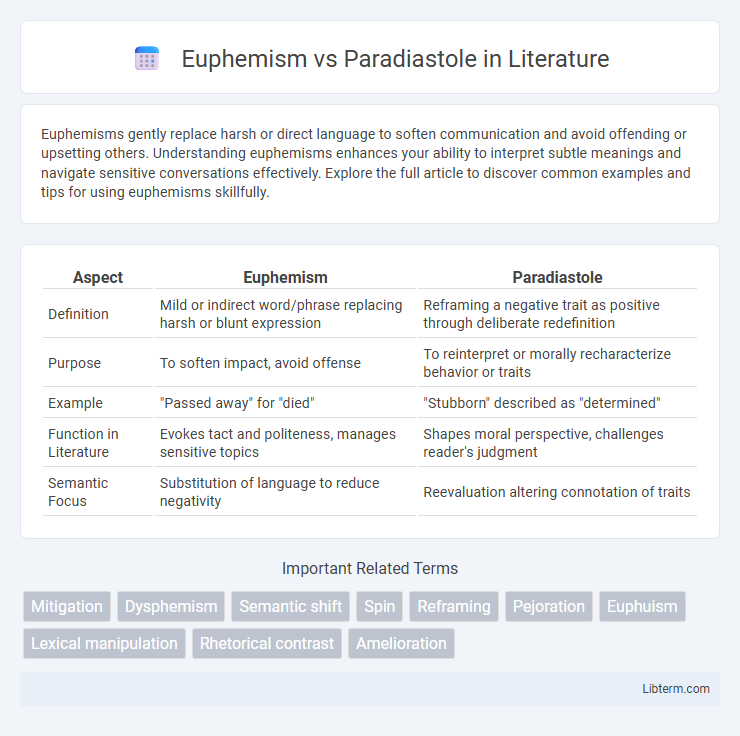Euphemisms gently replace harsh or direct language to soften communication and avoid offending or upsetting others. Understanding euphemisms enhances your ability to interpret subtle meanings and navigate sensitive conversations effectively. Explore the full article to discover common examples and tips for using euphemisms skillfully.
Table of Comparison
| Aspect | Euphemism | Paradiastole |
|---|---|---|
| Definition | Mild or indirect word/phrase replacing harsh or blunt expression | Reframing a negative trait as positive through deliberate redefinition |
| Purpose | To soften impact, avoid offense | To reinterpret or morally recharacterize behavior or traits |
| Example | "Passed away" for "died" | "Stubborn" described as "determined" |
| Function in Literature | Evokes tact and politeness, manages sensitive topics | Shapes moral perspective, challenges reader's judgment |
| Semantic Focus | Substitution of language to reduce negativity | Reevaluation altering connotation of traits |
Understanding Euphemism: Definition and Purpose
Euphemism involves replacing harsh or unpleasant terms with milder or more neutral expressions to soften the impact of a statement, often for social or emotional sensitivity. Its purpose is to mitigate offense, maintain politeness, or obscure unpleasant realities, making communication more palatable. Understanding euphemism is crucial for recognizing subtle language shifts that influence perception and tone in both everyday conversation and formal discourse.
What is Paradiastole? A Semantic Overview
Paradiastole is a rhetorical device that redefines negative traits into positive qualities by using mild or positive language, often to relieve criticism or soften judgment. Unlike euphemism, which replaces harsh or offensive terms with gentler expressions primarily to avoid discomfort, paradiastole consciously reinterprets moral or character flaws through linguistic reframing. This technique relies on semantic shifts and evaluative language to transform perceptions, emphasizing the role of context and speaker intent in meaning alteration.
Key Differences Between Euphemism and Paradiastole
Euphemism involves replacing harsh or offensive terms with more neutral or positive expressions to soften the impact of a statement, commonly used to address sensitive topics like death or bodily functions. Paradiastole, on the other hand, reinterprets negative traits by framing them as virtues or positive qualities, often employed in rhetoric to justify or redeem undesirable characteristics. The key difference lies in euphemism's purpose to mitigate offense through substitution, while paradiastole changes perception by recasting moral or evaluative judgments without necessarily avoiding the original term.
Historical Origins of Euphemism and Paradiastole
Euphemism originates from Ancient Greek, combining "eu" (good) and "pheme" (speech), historically used to soften harsh or taboo expressions for social decorum and religious beliefs. Paradiastole, also rooted in classical rhetoric, involves reinterpreting or rebranding negative traits as positive, often employed in Greek and Roman literature to morally reframe character flaws. Both techniques evolved as linguistic strategies to influence perception and maintain social harmony through carefully crafted language.
Linguistic Functions in Communication
Euphemism serves a linguistic function by softening or mitigating expressions that might be perceived as harsh or offensive, promoting politeness and social harmony. Paradiastole, on the other hand, redefines negative traits by recasting them as virtues, effectively altering perception through positive framing in communication. Both devices optimize discourse by managing emotional impact and influencing audience interpretation through nuanced language choices.
Euphemism in Modern Language Usage
Euphemism in modern language usage serves to soften or obscure unpleasant realities by replacing harsh or direct terms with more agreeable expressions, enhancing social communication and politeness. It is widely employed in contexts such as healthcare, politics, and everyday conversation to mitigate discomfort or offense, exemplified by phrases like "passed away" instead of "died." This strategic linguistic tool reflects societal sensitivity and evolving cultural norms that influence how sensitive topics are discussed.
Paradiastole: Rhetoric and Reframing
Paradiastole is a rhetorical device that reframes negative traits into positive qualities by emphasizing different moral perspectives, often using euphemistic language to soften criticism. Unlike euphemism solely aimed at polite expression, paradiastole strategically reinterprets character flaws as virtues, altering audience perception through nuanced moral recasting. This technique enhances persuasive communication by shifting ethical judgment, contributing to more effective argumentation in rhetoric.
Social and Cultural Implications
Euphemism softens harsh realities by substituting offensive or uncomfortable terms with milder expressions, often reflecting societal norms and taboos surrounding sensitive topics like death, poverty, or disability. Paradiastole, by contrast, reframes negative traits as virtues, influencing cultural narratives by shifting perceptions and moral judgments within social contexts. Both linguistic devices reveal underlying social values and power dynamics, shaping public discourse and individual attitudes toward identity, morality, and collective behavior.
Examples of Euphemism vs Paradiastole in Literature
Euphemism softens harsh realities with phrases like "passed away" instead of "died," as seen in Shakespeare's "Romeo and Juliet," where death is delicately referenced. Paradiastole reinterprets negative traits positively; in Jonathan Swift's "Gulliver's Travels," the term "savage" is recast to emphasize noble simplicity rather than brutality. Both devices manipulate language tone, but euphemism shields discomfort, while paradiastole redirects moral judgment.
Impact on Perception and Discourse
Euphemism softens harsh realities by replacing potentially offensive or uncomfortable terms with gentler expressions, thereby influencing audiences to perceive sensitive topics in a less threatening or more socially acceptable manner. Paradiastole reframes negative qualities as positive or neutral traits through deliberate redefinition, altering moral judgments and reshaping discourse by challenging preconceived values. Both rhetorical devices modify perception and communication, but while euphemism tempers severity to avoid conflict or discomfort, paradiastole actively recasts character or actions, significantly impacting ethical evaluation and narrative framing.
Euphemism Infographic

 libterm.com
libterm.com